|
This Webpage Title:
China - Yangtze River
China - Hong Kong - Macau
The Chinese call the Yangtze River, Chang-jiang, which means "Long River". The Yangtze River begins in the Tibetan Plateau and is fed by snow and ice melt from the surrounding mountains. The Yangtze empties out into the South China Sea near the city of Shanghai.

The Yangtze River is the largest river in China and the third largest in the world. It is about 3,900 miles long. Its width can range from eight to more than 1000 meters when the water rises.
The Nile and Amazon Rivers are larger than the Yangtze, but the Yangtze is special because it has so many people living near it.
About 350 million people live near the Yangtze River and its 700 tributaries.
The lives of the people living near the Yangtze are affected in some way everyday by the river. Dangerous floods kill people and livestock living near the river.
The watershed area of the Yangtze River is about 700,000 square miles, approximately 20% of China's total land area, and 25% of its total farming land area.
Almost all of the boating traffic in China is on the Yangtze River.

The Yangtze River winds through the most beautiful and exciting land forms in the world.
Once it reaches the edge of the Tibetan plateau, the river plunges off the "roof of the world," through huge gorges. The Three Gorges are famous for their steepness, beautiful wonders and tourist sites.
The walls of the gorges are steep and can reach as high as 3000 feet.
Ancient Chinese culture of Three Kingdoms, the great historical sites, beautiful river, majestic cliffs, grand canyon...all these collected in Three Gorges of Yangtze River.
It lets people to admire the Yangtze River. It is the greatest and most historical river in China as well as Asia. The Yangtze River is also the " Mother River " together with Yellow River in China .
The history of Yangtze River is also the main part of history of Kingdom Su--now the Sichuan province, and so the main part of history of China.
While cruising on Yangtze River, you can visit the ancient war site of Three Kingdoms, visit the only ghost city-Fengdu, to sense the famous poem of Tang Dynasty " The road toward Kingdom Su is as difficult as to approach heaven", "while the lonely boat sailing on the river under cloudless blue sky, there has nothing, but in front of you, the Yangtze River was fast running toward the horizon"
Three Gorges is the general name of Qutang Gorge, Wu Gorge and Xiling Gorge, which starts in Fengjie county of Sichuan province in the west and end in Nanjin pass of Yichang of Hubei province in the east. The total length is about 200 km and pass through Fengjie, Wushang, Baodong, Zhiqui and Yichang five counties/cities.

Wu Gorge starts at Daning River in west and ends at Guandukou of Hubei province in east,covering a distance of 40 kilometers.The gorge is characterised by its scenic spots, twisting rivers and streams as well as steep mountains,just like a natural gallery. There are all together twelve peaks along Wu Gorge,of which Godness Peak is the most scenic and well-known.The Godness is regarded as the symbol of Wu Mountain.
Zhangfei Temple Located in Yunyang County , Sichuan province, Zhangfei Temple is a building in memory of Zhang Fei,the famous general of Three States.Main buildings include Jieyi Building , Zheng Palace , Wangyunxuan Building and so on. There are many woodcuts, paintings, poems, stone carvings of famous people of past dynasties.
Waters of the Yangtze are often used for rice and wheat irrigation. It also has enormous and inexhaustible hydroelectric resources. In 1995 construction began on the Three Gorges Dam near Yichang and is scheduled for completion in 2009. The dam will measure about 600 feet and about 1.5 miles wide. The dam is expected to help control the flooding of the Yangtze River Valley . The Three Gorges (the Qutang Gorge, the Wuxia Gorge, and Xiling Gorge) will also be the largest electricity generating facility in the world. The hydroelectric generators will provide 1/9 of China 's total power output.
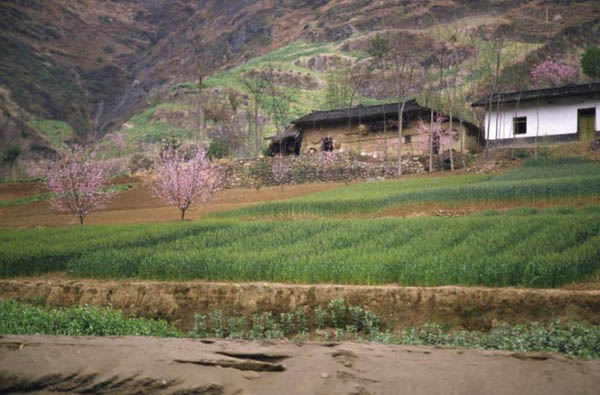
There is a lot of controversy surrounding the construction of the dams. There are 140 villages, 1,600 factories and over 80,000 acres of growable land that will be destroyed. It may also causes animals to become extinct. The area is very prone to earthquakes because it lies directly on a fault line.
One and a half miles wide and 610 feet tall, the gargantuan Three Gorges Dam is China 's largest construction project since the Great Wall.
The People's Republic of China decided to dam the Yangtze in 1994 with a steel and concrete wall that would take 15 years and over $30 billion to build. When completed, the dam will contain twice the amount of concrete of the Itaipu Dam in Brazil, currently the world's largest.
Damming will create a five trillion gallon reservoir hundreds of feet deep and about 400 miles long, able to absorb an earthquake measuring 7.0 on the Richter Scale. It will allow 10,000-ton freighters to easily navigate into the nation's interior and increase agricultural and manufacturing opportunities.
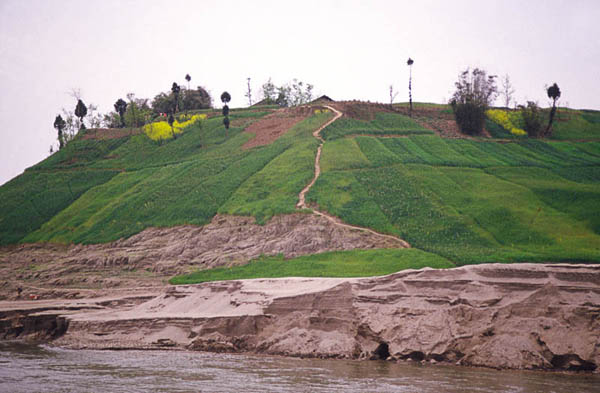
As the world's largest hydroelectric power plant, the dam's turbines are expected to create the equivalent electricity of 18 nuclear power plants.
The Yangtze River Water Resources Committee reported that 23.4 billion tons of sewage and industrial waste were dumped into the Yangtze in 2000. Currently, certain stretches of the river are unfit for human use, and many fear that the reservoir created by the Three Gorges Dam will become a massive cesspool.
Heavy farming and logging along the Yangtze has made it the fourth largest sediment carrier in the world.
Erosion along the banks could lead to enough of a water rise to create flooding. Sluices at the bottom of the dam have been designed to flush sediment through and prevent disaster, but such sluices have never operated on such an enormous scale before.
Every year the Yangtze deposits massive amounts of silt (more than 170 million cu m/6 billion cu ft annually), that helps make up the Jiangsu Province , a large plain used to grow rice. The fertile plains provide one of the most profitable areas of agriculture in China.
Today China accounts for 35% of the world's rice production. Rice is the world's single most important food crop and a primary food for more than a third of the world's population.
China seeks to provide for its increasing population with improved agricultural technology and increase in fertile land. The Yangtze provides crucial irrigation to the Jiangsu Province which continues to produce abundant harvests.
Yangtze River

The Chinese call the Yangtze River, Chang-jiang, which means "Long River". The Yangtze River begins in the Tibetan Plateau and is fed by snow and ice melt from the surrounding mountains. The Yangtze empties out into the South China Sea near the city of Shanghai.
The Yangtze River is the largest river in China and the third largest in the world. It is about 3,900 miles long. Its width can range from eight to more than 1000 meters when the water rises. The Nile and Amazon Rivers are larger than the Yangtze, but the Yangtze is special because it has so many people living near it.
About 350 million people live near the Yangtze River and its 700 tributaries. The lives of the people living near the Yangtze are affected in some way everyday by the river. Dangerous floods kill people and livestock living near the river.
The watershed area of the Yangtze River is about 700,000 square miles, approximately 20% of China's total land area, and 25% of its total farming land area. Almost all of the boating traffic in China is on the Yangtze River.
The Yangtze River winds through the most beautiful and exciting land forms in the world. Once it reaches the edge of the Tibetan plateau, the river plunges off the "roof of the world," through huge gorges. The Three Gorges are famous for their steepness, beautiful wonders and tourist sites. The walls of the gorges are steep and can reach as high as 3000 feet.
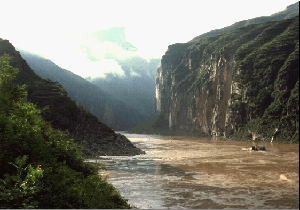
Qutang Gorge
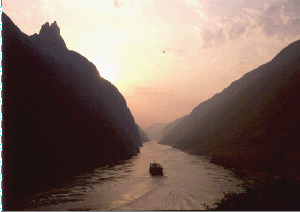
Wu Gorge
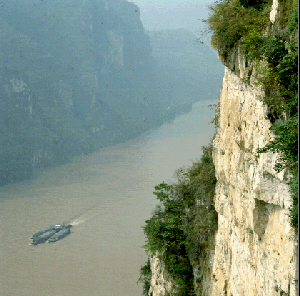
Xiling Gorge
. 
Boating on the Yangtze River.
. 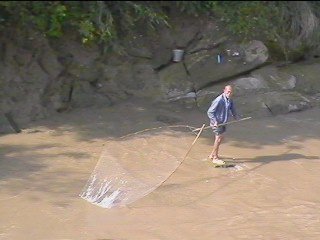
Fishing along the Yangtze.

Workers loading a cargo of watermelons on a ship on the Yangtze River.
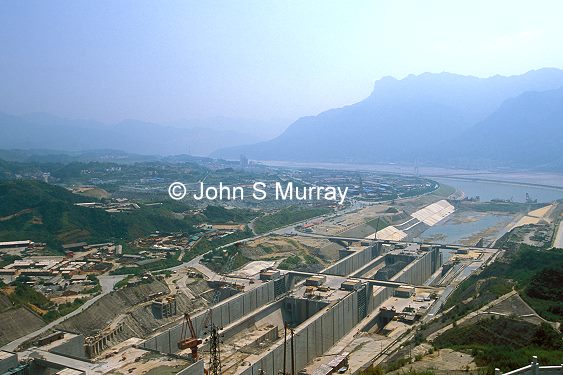
Construction of the 3 Gorges Project. 
|